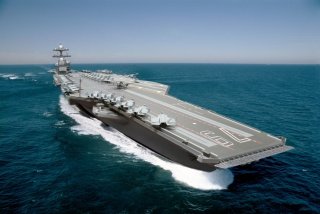Close Call: Why the Navy Always Bombs Its New Aircraft Carriers
Having Shock Trials as soon as next year is considered a major milestone as the ship nears its anticipated operational service several years from now.
Here's What You Need to Know:
The Navy will explode bombs near its new USS Ford aircraft carrier as soon as next year to assess the new platform’s ability to operate in high-threat, major-power warfare on the open seas. They are called Shock Trials, a specific combat preparation exercise wherein Navy testers fire a wide range of weapons against or near the ship in a variety of different sea states.
Service weapons testers will detonate a wide range of bombs, including a variety of underwater sea mines to assess the carrier’s ability to withstand enemy attacks. “Shock Trials,” as they are called, are typically one of the final stages in the Navy process designed to bring warships from development to operational deployment.
A report from USNI states that USS Ford Shock Trials are slated for 2021. Having Shock Trials as soon as next year is considered a major milestone as the ship nears its anticipated operational service several years from now. For instance, the Shock Trials may help move preparations along for the USS Ford, which has been experiencing some maintenance and technical delays.
Interestingly, an essay on Shock Trials from several years ago explains that detonating bombs near the ship closely approximates the kinds of serious threats the ship might face in full combat. A 2007 Department of Defense-directed Shock Trials analysis by the non-profit MITRE corporation explains that many of the expected or most probable threats to warships come from “non-contact explosions where a high-pressure wave is launched toward the ship.”
MITRE’s report, interestingly, also identifies the inspiration for Shock Trials as one originating from World War II.
“During World War II, it was discovered that although such 'near miss' explosions do not cause serious hull or superstructure damage, the shock and vibrations associated with the blast nonetheless incapacitate the ship, by knocking out critical components and systems,” the MITRE assessment, called “Navy Ship Underwater Shock Prediction and Testing Capability Study” states.
The MITRE analysis further specifies that, following a nearby explosion, the bulkhead of a ship can oscillate, causing the ship to move upward.
“Strong localized deformations are seen in the deck modes, in which different parts of the decks move at different frequencies from each other,” MITRE writes.
The first-in-class USS Ford has been specifically engineered for expanded air attack, being built with a larger deck space than the Nimitz-class to enable a greater sortie rate. Navy developers explain that the Ford configuration was developed to increase the air mission rate by as much as 33%, with a mind to creating a new dimension of air power projection. This strategy, initiated years ago, did seem to anticipate what could be described as a modern threat environment. More air power would be needed in any kind of major-power engagement, carriers need to have an ability to operate the first-of-its kind carrier-launched F-35C5 stealth fighter, and perhaps of equal or greater significance, modern carriers need to have longer attack reach.
Kris Osborn is the new Defense Editor for the National Interest. Osborn previously served at the Pentagon as a Highly Qualified Expert with the Office of the Assistant Secretary of the Army—Acquisition, Logistics & Technology. Osborn has also worked as an anchor and on-air military specialist at national TV networks. He has appeared as a guest military expert on Fox News, MSNBC, The Military Channel, and The History Channel. He also has a Masters Degree in Comparative Literature from Columbia University.
This article first appeared in July 2020.
Image: Flickr.

